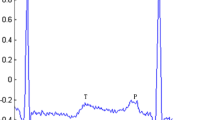Abstract
A computerised system for the 3-dimensional dynamic display of joint interval histogram (j.i.h.) of heart beats was developed. It presents a dynamic histogram of a programmable number of beats on an oscilloscope screen. The 3-dimensional display of the j.i.h. was found to be characteristic of rate and rhythm disturbances. The system facilitates the monitoring of transient arrhythmias. It can serve for the detection and quantisation of ventricular and supraventricular extrasystoles, rate changes and statistical evaluation of atrial fibrillation. The system was used in the Intensive Coronary Care Unit and is suggested as a useful tool in cardiac patient monitoring in addition to real-time e.c.g. display.
Similar content being viewed by others
References
Becker, J. C., Wallace, J. andNelsen, T. S. (1968) On line generation of a joint histogram from slow rhythmic biological potentials.Med. & Biol. Eng. & Comput.,6, 415–423.
Hershberg, P. I. andKantrowitz, A. (1967) A pulse interval predictor.Appl. Physiol.,22, 840–842.
Holmes, J. R. (1972) Use of an on line computer in a study of cardiac arrhythmia.J. Electrocardiol. 5, 333–339.
Krekule, I. andSkvaril, J. (1976) Compilation of joint interval histogram using a biomedical data analyzer.Comput. & Biomed. Res.,9, 7–10.
Rowlands, D. J., Taylor, C., Hanson, P. T. G., Howitt, G., Davies, E. T. L. andPullan B. R. (1970) Cardiac rhythm display using the joint rate histogram.Cardiovascular Res.,4, 531–536.
Schamroth, L. andDove, E. (1966) The Wenckebach phenomenon in sino-atrial block.Br. Heart. J.,28, 350–358.
Schulman, J. H. andThomson, J. (1964) On-line analog generation of joint-interval histogram.Rev. Sci. Instrum.,35, 13–14.
Simborg, D. W., Ross, R. S., Lewis, K. B. andShepard, R. H. (1966) TheR-R interval histogram. A technique for the study of cardiac rhythms.J. Am. Med. Assoc.,197, 867–870.
Södenström, N. (1950) What is the reason for ventricular arrhythmia in cases of auricular fibrillation?Am. Heart J.,40, 212–223.
Stinton, P., Tinker, J., Vickery, J. C. andVahl, S. P. (1972) The scattergram. A new method for continuous electrocardiographic monitoring.Cardiovascular Res.,6, 598–604.
Ten Hoopen, M. andBongaarts, J. P. M. (1969) Probabilistic characterization ofR-R intervals.—Ibid.,3, 218–226.
Author information
Authors and Affiliations
Rights and permissions
About this article
Cite this article
Mahler, Y., Setton, A. & Rogel, S. Computerised dynamic 3-dimensional joint interval histogram display for arrhythmia monitoring. Med. Biol. Eng. Comput. 20, 129–133 (1982). https://doi.org/10.1007/BF02441347
Received:
Issue Date:
DOI: https://doi.org/10.1007/BF02441347



